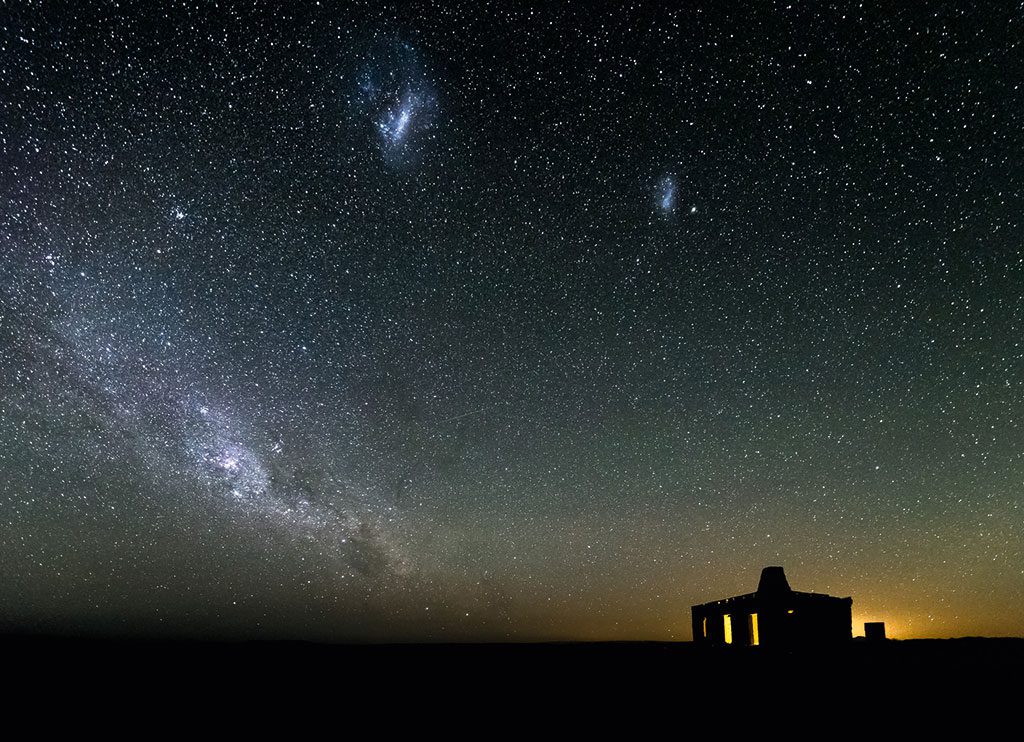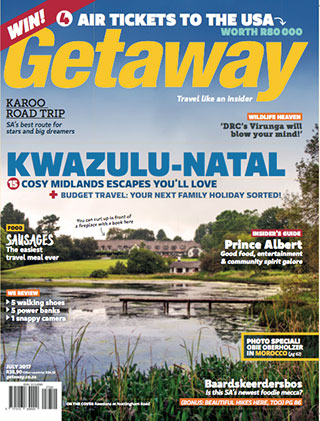
Karoo skies are among the clearest on Earth. Keep it simple with this easy road trip and get off the tar to see the stars.
There’s no better place to experience it than in this wide-open land.

Clear skies with visible stars in the Karoo. Photo by Chris Davies.
The back roads of the Karoo have a strange effect on the mind. It’s as if mile by mile they clear you out, forcing your attention into equilibrium with the passing veld, slowly finding balance, until inside and out are united in a single vast expanse, where koppie-like thoughts appear slowly, take shape, then vanish in the mirror behind. In a sense, all roads through the Karoo are back roads – even a quiet morning on the N1 can conjure this effect – but the gravel meanderings are where everything is at its most uninterrupted.
There are no cars out here. No activity of any kind it seems. A Springsteen song shuffles onto the playlist and I glance beside me at Ann, my companion on this desert detour. She is lost in thought: legs drawn up on the seat, chin on knees, staring out the window. Her fingers tap absentmindedly on her shins as Bruce makes the dusty African heat feel like a New Jersey morning skyline. Yeah Bruce, they’re both a lunar landscape, for real.

A view from Die Mond campsite. Photo by Chris Davies.
The mind abhors a vacuum and mine, apparently, can never be entirely empty. With daily anxieties driven out, old memories rush in and I find myself thinking of someone I haven’t in years: Tony Fairall, my Astronomy 101 professor at UCT.
That one semester of lectures – back when you could still get creative with your first-year choices, despite a major in English – is, without doubt, the only thing of substance I remember from three years of university. Prof Fairall’s passion, enthusiasm and wonderful bi-monthly sessions at the Cape Town Planetarium instilled in me not just a love for the stars, but an enduring interest in what they’re all about; at least as far as we know. He died in 2008 in a tragic diving accident off Hout Bay, but I’ve always remembered those lectures. More accurately, I’ve forgotten them too, but at least, having forgotten, I’ve made the effort to learn again.
The sun is low on the horizon as we pull into Kambro’s campsite, grab a takeaway pie for dinner, and pitch the tent. If daytime in the Karoo is about the immensity of the landscape, the night is about the immensity of the sky. Scorpius, my favourite constellation, is rising and I point it out to Ann, who humours me and nods as if she’s never seen it before. I mention that Antares, the bright red star at its centre, is so big it would engulf Earth and Mars if it were centred on our sun. This gets a more thoughtful response, although I’ve gone on about that before too, and my ego gives another nod to Prof Fairall and Astronomy 101.

Camping at Kambro accommodation and farm stall. Photo by Chris Davies.
The next day we pack early and head south-west, taking dirt roads wherever possible – not because they are quieter (even the ‘main’ roads are quiet out here), but because the Karoo feels better on dirt: older, more solid. Past Pampoenpoort, we turn west towards Carnarvon. Beyond, 70 kilometres out between the koppies, the South African section of the Square Kilometre Array (SKA) radio telescope is under construction, and will be for the next decade or more. The first phase will go online later this year.
Back in my varsity days, the astronomical community was abuzz with the 11-metre Southern African Large Telescope (SALT) in Sutherland, then still five years from completion. Twelve years after opening, SALT is still among the largest optical telescopes in the world, and the largest in the southern hemisphere, but SKA is the next big thing, a really big thing, a ‘megascience’ project comprising an array of telescopes spanning 10 countries and two continents: Africa and Australia. Combined, it’ll be the largest telescope of any kind to peer out into the universe and super-fast super computers must be built just to cope with the incoming data, expected to be many times the volume of the world’s total Internet traffic per second.

No sound evokes the Karoo quite like the rhythm of a creaking windmill. Photo by Chris Davies.
Both installations are centred here because the Karoo has some of the clearest night skies in the world, and because, until recently, all large telescopes were built close to or within their funding nations, leaving much of the southern sky unobserved. Well, not unobserved, just far less scrutinised.
I remember being disappointed when I realised SALT wasn’t something you could stick your eye up against and watch distant galaxies pop into focus like cells under a microscope. Everything is computerised these days, and while the final rendered images are beautiful, they still fail to eclipse the awe I feel seeing the full swathe of the Milky Way in a pitch-black southern sky. And that seems right, I think.
At Middelwater Campsite that night we pull our chairs from under towering trees and sip our red box wine, made vintage by the splendour above. Ninety kilometres to the north-west, SKA is taking shape in the darkness and above us a lone satellite tracks a pale arc past the Southern Cross.
We wake late, making the most of the leafy canopy above. Except for a few parked cars in Fraserburg, we see only one bakkie and a donkey cart all the way to Sutherland, where we catch our first glimpse of the huge dome that is SALT, on its high plateau outside town.
Sutherland is quiet in the late afternoon, and even quieter at night. Once again, a moonless sky soars above and we say little, just stare and think. You’re supposed to be able to see two or three thousand stars with the naked eye on a clear night. It seems a ridiculous underestimate, but I don’t try to count.

Prickly pears about to bloom. Photo by Chris Davies.
Down Ouberg Pass into the Tankwa the next day, we stop at an abandoned barn for lunch, but quickly vacate when we find a hive of bees ensconced on the ceiling. Outside the massive heat drives us onwards and I try to imagine the cold, dark enormity hiding behind the baking blue above.
At the oasis of Die Mond Campsite, with starlight gleaming off the incongruous water before us, it strikes me that these totally remote, vast landscapes are the perfect mirror for the immensity of the universe above. No city night sky can reveal this profusion. And who would want that? You have to be as far away from people as possible to see as far into the night as this. Or maybe take a trip to the planetarium. It’s a memorable experience, though not quite the same.

Sunset in the Karoo, when a near-endless landscape hands over to an utterly endless night. Photo by Chris Davies.
Get star-ted
It’s 7 hours down the N12 from Joburg to Kambro Accommodation and Farm Stall (1), 22km north of Britstown. Alternatively, from the N1, take the well-graded dirt DR3088 from Colesberg to Philipstown, then drive west for an hour on the tarred R48 and N10. If you have time (2½ hours), you’ll find absolute solitude on the gravel detour south of Philipstown instead.
Day 1: Kambro to Middelwater
Distance 260km Allow 4½ hours
Kambro Accommodation and Farm Stall sells meat, beer, wood and all manner of padkos so stock up if you haven’t already. Then head south on the N12 to Britstown, and west on the tarred R384. 20km out of town, turn left onto the gravel DR3070 and meander along to Vosburg, then make another left onto the AP2997 to Pampoenpoort. Turn right at the Pampoenpoort T-junction for another long, lone meander north-west to Carnarvon, then it’s back onto tar for exactly 30km, down the R63, before a right turn onto dirt for the final 5km to Middelwater Campsite (2) and the biggest trees you’ve seen all day.
Day 2: Middelwater to Sutherland
Distance 300km Allow 5 hours
From Middelwater, head back north to Carnarvon and take the Tiervlei gravel road south-west to Fraserburg. Continue southwest on the AP2259 and, as you join the R356 ‘thoroughfare’ to Sutherland (still dirt), look west for your first glimpse of the South African Astronomical Observatory (3) on the high plateau ahead. Drive the last few kilometres of tar to Sterland Caravan Park (4). No time to cook and visit the observatory? Grab a burger at The Whitehouse Inn (5) en route.
Day 3: Sutherland to Die Mond
Distance 170km Allow 4 hours
Head south out of Sutherland, and turn immediately right onto the dirt road to Ouberg/Bo-Visrivier – there’ll be no more tar until Ceres. Continue west down Ouberg Pass and follow the signs to Tankwa Karoo National Park and Ceres. Drive through the park (no permit required), turn right onto the R355 for 8km, then left for a final 20km to Die Mond Campsite (6) and a swim! The bright lights of Cape Town are still 280km and four hours away.

Die Mond campsite. Photo by Chris Davies.
Directory
1. Kambro Accommodation and Farm Stall. Six grassed campsites are discreetly spaced, each with electricity, light and a private braai. R180 per stand (sleeps four). The 10 self-catering units are from R290 per person sharing (sleep two to six). The farm stall is bursting with Karoo goodies, and you can order light meals to eat there or take away (pie, chips and salad for R60). Larger meals are also available from R180 per person, but must be booked in advance. Tel 0833056668.
2. Middelwater Campsite. Pitch your tent under the trees, and move into the open when the stars come out. There’s a dam for swimming (rain dependent), plus a small, but impressively neat ablution and donkey shower. Camping is R180 per stand (sleeps four, no electricity). Tel 0746470447.
3. South African Astronomical Observatory. Time your road trip for a guided tour of the visitor centre and research telescopes, including the 11-metre SALT telescope. Tours run Monday to Saturday 10.30am and 2.30pm (adults R60, kids R30). The visitor centre holds stargazing sessions on Monday, Wednesday, Friday and Saturday, starting at 6pm in winter and 8pm in summer (adults R80, kids R40). The research telescopes, including SALT, are off-limits after dark. Tel 0235712436.
4. Sterland Caravan Park. There are seven stands with power and private braais. Camping is R100 per person. Sterland runs five guest houses in town for R395 per person B&B (sleep two to six). Owner, Jurg Wagener, runs great stargazing sessions from the campsite for R100 per person. 0235711481
5. The Whitehouse Inn. Open seven days a week, serving light meals until 9pm (excellent burger and beer special for R80). Tel 0235711444.
6. Die Mond Campsite. Lush grass stands on the banks of the wide, cool Grootrivier. Camping is R70 per person (no power). There are seven self-catering cottages from R100 per person (sleep five to seven). No dogs. Tel 0233170668.
What we’d do differently
Spend more time at Die Mond. It’s hard to describe the feeling of diving into cool fresh water after days on the Karoo’s dusty dirt roads.
This story first appeared in the July 2017 issue of Getaway magazine.
Our July issue features the best places to stay in the Midlands, budget family breaks in Durban, and the best (and mostly free) things you have to do in New York.

This article, Go stargazing on this easy Karoo road trip, was originally posted on the Getaway Blog by Chris Davies.